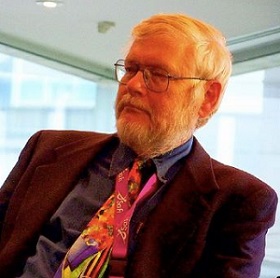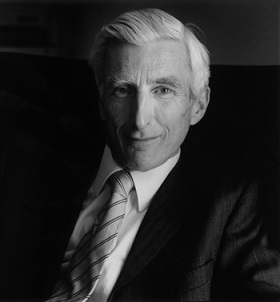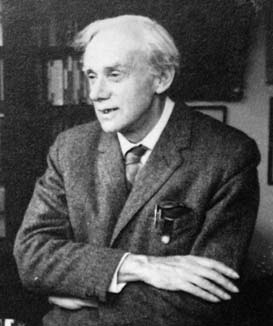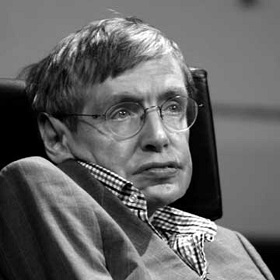Ever wonder what it would have been like to sit in on a great occasion? I used to think about this in relation to a dinner party the painter Benjamin Haydon threw in 1817 at his London studio. At the ‘immortal dinner’ were, among others, William Wordsworth, John Keats and Charles Lamb, leading literary figures of their day. Fortunately, gatherings like these aren’t relegated to the 19th Century. In a piece that ran originally in The New York Review of Science Fiction, Gregory Benford describes an equally extraordinary evening with some of the greatest minds of our time: Martin Rees, Stephen Hawking, and Paul Dirac. A physicist and award-winning science fiction writer, Benford relates the particulars of a Cambridge sabbatical as scientists at the top of their form meet for an evening of bonhomie, whimsy and reflection.
by Gregory Benford

In science one tries to tell people, in such a way as to be understood by everyone, something that no one ever knew before. But in poetry, it’s the exact opposite.
–Paul Dirac
The invitation was on heavy bond in a delicious oyster color. I opened the Trinity College envelope noting it bore no stamp, apparently placed in my Institute of Astronomy mailbox by hand. Flowing script invited my wife Joan and me to evening meal with Professor Martin Rees.
Very good; the full High Table college show, then. In 1976 I was on sabbatical as a visiting fellow in Cambridge, England. I went there to study pulsars where they’d been discovered, but quickly became more interested in the luminous jet just seen in radio frequency maps of M87, the nearest active galaxy.
Martin Rees was then the Plumian Professor of physics and the director of the Institute of Astronomy, appointed just after the departure of Fred Hoyle. He had agreed to host my sabbatical, a stay that began my astrophysics career; I’ve spent the decades hence mostly on pulsars and galactic jets. In Cambridge I learned much more than I anticipated.

Precisely on time Joan and I walked through the Great Gate, the main entrance to the college, leading to the yawning Great Court. In the centre of the court stood an ornate fountain, traditionally fed by a pipe from Conduit Head in west Cambridge, not the unreliable Cam River nearby. A solemn porter in a black bowler hat welcomed us, remarking gruffly on the chilly air, and nodding at the invitation as I presented it. “Ah, the Rees room.”
Image: Cosmologist and astrophysicist Martin Rees, whose books and lectures explore not only astronomy but the bounds of science, philosophy and humanity’s place in the cosmos.
Trinity College undergraduates passed in gowns of dark blue. A statue of the college founder, Henry VIII, greeted us from a shadowy niche above the doorway. Martin Rees stood beside it, a slight man with a hawk nose and incisive gaze, bowing to Joan with a broad smile. I imagined we’d eat at the high table, as I had before for lunch, but instead Martin took us into a private dining room. I walked in with Joan and saw at the table two men and their wives: Paul Adrien Maurice Dirac and Stephen Hawking. Martin had said nothing to alert us.
Newton, Nehru and Maxwell were alumni of Trinity, and Dirac stood in such company; soon, so would Hawking and Rees.
The dining room was small, with room for six at the table. Soft lighting cast glows on the dark wood walls amid the scene of 700 years of academic elitism. The leadened plates stamped with the famed Trinity monogram framed a small salad. The flatware was heavy, dark silver and tall stemmed glasses ranked to the side. The servers wore formal tuxedo styled clothes and professionally disinterested faces. The headwaiter handled all dishes with white gloves and led the two solemn under-waiters.
I said very little through the salad, letting Joan carry our side. She entertained them with stories to adapting to English home appliances, her tinkling laughter softening the atmosphere. I reflected. Dirac had won a Nobel in 1933 for the first relativistic theory of particles, the Dirac equation. “The great papers of the other quantum pioneers were more ragged, less perfectly formed than Dirac’s,” my friend Freeman Dyson had said to me when I was in graduate school. Freeman had taken Dirac’s Cambridge quantum mechanics course as a precocious 19-year-old. Of Dirac’s discoveries, Freeman said, “His papers were like exquisitely carved marble statues falling out of the sky, one after another. He seemed to be able to conjure laws of nature from pure thought.”
This is an evening to keep your mouth shut, I thought, sitting at the centuries-old table and sipping a light Chardonnay (French, of course) served with the salad. Next, a tasty soup arrived, attended in strict silence by the stiff waiters. I noted that the French red wine was older than I was, a 1938 from the Fellows’ Cellar. A Haut Medoc, it was deep and rich with a surprising plum aftertaste.
Famously, Dirac’s wife Manci spoke little, and he even less. His colleagues in Cambridge jokingly defined a conversational unit of a dirac — one word per hour. Rees had related to me already how a while back all the physicists in Cambridge had newborn daughters, and someone said, “There must be something in the air.” Without pause Dirac, who had two daughters, said, “Or in the water.”
Dirac was a slight man and autistic, widely known as hard to draw out. He said this concentration proved crucial to his success as a theoretical physicist, for he could remain focused on a problem for a long time. He also could order information about mathematics and physics in a systematic way, employing his visual imagination and determination. (Decades later, I saw medical practice focus on this supposed disorder, “fixing” it with drugs and therapy. How many geniuses have we lost this way?)

I asked him how he concentrated solely on his research. “I don’t talk,” he said with admirable brevity and a smile. He also said he only stopped work on Sunday, when he took long strolls alone. He had struggled to find the Dirac equation for months, getting nowhere, then took his usual Sunday walk—and the entire solution came to him when he was crossing a small bridge. He hurried to a nearby pub, asked for lunch and wrote the equation on the back of the menu so he would not forget. He seldom looked directly at anyone, but this time he stared me in the eye. “There it was, out of nowhere.”
Image: Nobelist Paul Dirac, a founder of quantum mechanics and quantum electrodynamics, who predicted the existence of antimatter.
“Do you still have the menu?” I asked, eyes wide. When I said it would be a charming historical momento, he dismissively waved his hand. He had used it to start a fire in his chilly college rooms.
The Navy bean soup done, talk moved on. Some mention of English politics arose, at a time when Maggie Thatcher was moving to the fore, Martin squelched with, “I’m entirely infra-red,” which meant something like Trotsky. He had no wife then. Hawking’s wife rolled her eyes at this statement, saying nothing.
As the waiters smoothly placed plates of veal ala brochard before us, Hawking changed the tone of the conversation with his halting words. He wanted to talk about science fiction. Martin had told him I wrote the stuff. I’d had the impression that at Cambridge science fiction was something serious scientists never would do, and seldom discuss — especially at a table where Newton changed the world over bowls of steaming lentil soup—and I said so. Hawking gave a slanted grin. “Fred Hoyle has left us, but he is not forgotten.”

Hawking talked in slurred tones about what we now call his “chronology protection conjecture”. Why does nature apparently abhor a time machine? He said, “It seems that there is a Chronology Protection Agency which prevents the appearance of closed timelike curves and so makes the universe safe for historians.”
Martin pointed out that there was strong experimental evidence in favor of the conjecture — from the fact that we have not been invaded by hordes of tourists from the future. All this discussion Hawking eventually included in a book in the 2000s, along with his fears that our TV broadcasts, would bring ravening aliens to our door. He thought about such speculations in the 1970s, but apparently kept them largely to himself during his climb to fame.
Image: Theoretical physicist Stephen Hawking, famous among many things for his work on black holes and general relativity. Like Dirac, he held Cambridge’s Lucasian professorship of mathematics.
Dirac spoke about the walks he took around Cambridge, relating favorite routes in great detail, but otherwise had no small talk. Slowly Hawking turned the conversation around to what books we read, asking each of us. He then announced that since he was thirteen he had never bothered with the assignments in Literature classes, preferring science fiction. Dirac remarked, “In science one tries to tell people, in such a way as to be understood by everyone, something that no one ever knew before. But in poetry, and I suppose in fiction, it’s the exact opposite.”
To my surprise Rees assented. “But science fiction leads to science,” he said. Dirac was silent and looked puzzled.
Stephen spent a long while relating memories of sf short stories he’d read. Like many fans, Hawking could recall ideas but not authors or titles. He was a big Robert Sheckley fan, I deduced, from what his remembered plots. Rees said he thought science fiction was like a literary dialect. It had its own vernacular and insider terms, its unusual pronunciation patterns and rhythms. A native sf “speaker” uses the argot of an audience, one that knows what Delany later called the sf reader protocols – signals of broader meaning. A good example is, “The door dilated,” implying a changed world. Nods all round, though Dirac said he had read little sf beyond Wells and Brave New World. “Perhaps I should.”
We all agreed that aliens in fiction serve as a distorting mirror to show what humankind is not. Hawking spoke with jerky gestures, fighting the erosions from his Amyotrophic Lateral Sclerosis, which I knew as Lou Gehrig’s disease. His speech was slurred, brief and almost unintelligible, his conciseness a skill that later worked well in A Brief History of Time. Hawking’s fame was rising on his striking research ideas–that empty space wasn’t empty after all, and black holes aren’t black.
His wife, with her tight, focused look, scoffed at ideas like aliens, likening them to imaginary beings. Stephen retorted tartly that so were angels. A sudden silence around the table. I sipped the wine, which was excellent and still blossoming with rich new tones. This incident prefigured the issue of her Baptist faith versus his firm atheism, which eventually split them up.
I recalled this evening lately, looking over notes I made that very evening. My wife Joan died of cancer in 2002. In 2005 Rees was elevated to a life peerage, sitting as a crossbencher in the House of Lords as Baron Rees of Ludlow, a seat in the County of Shropshire. By then Astronomer Royal, he told the British Interplanetary Society, ‘”It is better to read first-rate science fiction than second-rate science; it’s no more likely to be wrong and is far more stimulating than second-rate science. And I think it’s good to read the great classics of science fiction.”
After a five course meal we had the finishing treat: an English, less sweet, version of crème brûlée, known as “Trinity burnt cream.”
Now Martin is master of Trinity College and the best known astronomer in the world. Recently, in Our Final Hour, he predicted that one of the two following outcomes is inevitable for humanity:
Extinction from runaway effects of new technology (nanotechnology, robotics) or else from uncontrolled scientific research; terrorist or fundamentalist violence; or destruction of the biosphere;
or else
Our expansion into space, survival through colonization. He now advocates free markets and believes that the wealthy will push back the frontiers of space.
Not infra-red any longer.
I never saw Dirac again, but have kept up with Hawking and Rees through the decades, visiting Cambridge often. They both use science fiction in their popular writing, whereas in the 1970s that was not the sort of thing you mentioned at High Table. Our world has changed, partly because of those men.
What distinguished them the most, I think, was their quiet verve, their wish to grapple with life. They were eager to deal with whatever came at them. Dirac probed our fundamental understanding of the world in his monk-like solitude. Hawking persevered against his crippling disease to become a major cosmologist. Rees cannily wove his way into great power, urging the Institute for Astronomy to the forefront of the field, becoming Astronomer Royal, and a major figure bringing science to the public as well.
The evening left a deep impression on me. On the walk home, I remarked to my wife that I would probably never have a better evening–at least, with my clothes on. She took that as a challenge and made the evening even more so.
From my time there I gathered background that eventually appeared in my 1980 novel Timescape, which explores how scientists confront the unknown. Cambridge is steeped in tradition, but its scientific culture is radical. I hope it remains so.
Copyright 2013 by Gregory Benford



I enjoyed this very much. At 16 I found Oxford overwhelming, but it got better! I read Physics at Hertford, btw
What a fun article to read – thanks….
Very rewarding anecdote. My own would be far less exalted, albeit no less enlightening to me personally – mostly conversations with humble observational scientists at California state colleges rather than elite theorists in world-renowned institutions. Unfortunately, I don’t have the kind of memory that records the details of conversations, so mostly I only remember the ideas that arose rather than their exact conversational genesis.
My favorites are always with exoplanet people. Lot of fun imagining exotic detection methods to find gruesomely difficult hypothetical planets, e.g. small planets in distant orbits around massive and bright stars in an orbital plane perpendicular to the line of observation.
BTW, I have some distinct memories regarding “Timescape”. I had gotten a used copy of it from a small bookstore (along with a number of others) as payment for helping them move when I was 15. I was a chain-smoker at the time, so I’d sit outside this coffee shop in the same complex as the book store with a Camel in my mouth and read this book. It seemed like a kindred work to Robert Forward’s stuff, very cause-and-effect oriented in a detailed way that more adventure-oriented fiction tends to ignore. Still have that book on my shelf, although it’s not in good shape.
When working on my PhD I was introduced to Dirac once, that’s all introduced, because he came to the University of Texas to give a lecture. We were all in awe of him.
I always wondered why it was not Sir Paul, after all he was the greatest British theoretical physicist of the 20th century. It took a while to find out. The biography of Dirac : The Strangest Man: The Hidden Life of Paul Dirac, Mystic of the Atom, Graham Farmelo , 2009, Basic Books , we find that Dirac turned down a knighthood. Did not know one could do that, but others have, Hawking being another. (The Farmelo is the finest biography of Dirac there is, I recommend it.)
The unification of quantum mechanics and special relativity in Dirac’s equation and the prediction of the positron should have netted Einstein a second Nobel, even tho Special Relativity had other experimental proof. It would have today but never happened.
I love this quote from Farmelo’s book.
“Dirac just finished giving a lecture to colleagues. Someone in the audience raises his hand and says: “I don’t understand the equation on the top-right-hand corner of the blackboard.” Dirac says nothing. The audience shuffles nervously. After a long interval of uneasy silence, the moderator asks Dirac if he wants to answer the question. Dirac laconically replies: “That was not a question, it was a comment.”
Dr. Benford: thank you SO much for sharing your memories of that private evening:
“The evening left a deep impression on me.”
And for mastering understatement.
I find it uncomfortable that leading scientists are worshiped as little gods. Their opinions held above lesser known scientists even if ultimately wrong. Being in their presence brings meaning. This amounts to science by personal authority or reputation and if anything should be more evenhanded and based on ideas alone it should be science. I believe this very human tendency actually slows down the progress of science.
Well, they don’t worship each other. Martin Rees, for instance, has little use for some of Stephen Hawking’s views:
http://www.independent.co.uk/news/people/profiles/martin-rees-we-shouldnt-attach-any-weight-to-what-hawking-says-about-god-2090421.html
Hello,
The ‘dinner’ referenced above ;
http://www.amazon.com/The-Immortal-Dinner-Laughter-Amsterdam/dp/1561310719
Best regards,
Mark
And I do not buy into Hawking’s views on ETI, which sound an awful lot like the plot from Independence Day. See here:
https://centauri-dreams.org/?p=14703
…and here:
https://centauri-dreams.org/?p=14754
Of course the media, which seems to be degrading on a daily basis when it comes to understanding science and technology, eats up whatever folks like Hawking have to say on just about any subject, because they are seemingly smarter than the average person.
Though it’s funny: When Hawking said that advanced aliens coming to Earth would be a threat to us, the general public quickly agreed and let his pronouncement confirm their already existing fears on the subject. But then, when Hawking also said he did not think there was a God, suddenly the masses responded with a collective “That wacky scientist doesn’t know what the heck he’s talking about!” :^)
Of course Hawking is not infallible even when it comes to his scientific specialty:
https://centauri-dreams.org/?p=14754
Just as that other giant of science, Sir Isaac Newton, was an alchemist and Biblical numerologist. And kind of a jerk.
Possibly it was Newton’s interest in hermeticism (“as above, so below”) that inspired him to look for a single force that could account both for the behavior of objects near the ground and the motion of the planets. People’s minds aren’t divided into separate compartments. Supposedly the person that discovered the benzene ring was inspired by a dream, and Bohr thought of quantum theory after reading about Kierkegaard’s religious “leap of faith” (an instantaneous change of state). I sometimes wonder if the increasingly specialized education of scientists isn’t making it less likely that ideas will come out of left field.
NS said on August 5, 2014 at 12:46:
“I sometimes wonder if the increasingly specialized education of scientists isn’t making it less likely that ideas will come out of left field.”
That and the fact that everything is becoming so corporate where one has to be making a quarterly profit on their product or don’t bother. Perhaps we will have to keep relying on that one inquisitive, energetic person working in their basement or garage on their own time for the new breakthrough ideas. Assuming big business and society/government at large let him or her retain their individuality.
A biographical film about Hawking coming this November:
http://www.universetoday.com/113728/theory-of-everything-trailer-for-movie-about-stephen-hawking-now-available/
Although the image of leading scientists is a product, just like the image of any celebrity in the modern world of media, they do deserve personal respect and attention for having though out some things beyond what others have been able to do.
Top scientists have aided our understanding of the world, and their ability to think out complex and abstract equations, or pursue difficult experiments and interpret them is a skill our society needs. That doesn’t make scientists into experts in other fields, of course, and the attention we give them then is more a reflection on us and our need for guidance than on them.